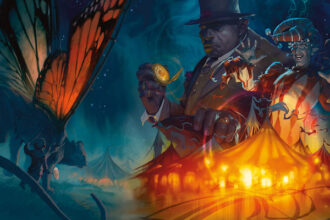In a Goblin Market

Backwards up the mossy glen
Turn’d and troop’d the goblin men,
With their shrill repeated cry,
“Come buy, come buy.”
–“Goblin Market,” Christina Rosetti
In the last two articles in this series on the fey, I’ve talked about courtly fey and the terror of the Wild Hunt. Today I’m moving on to goblin markets and the fey penchant for temptation and trade. Now, you can get here using the stat block of the Monster Manual goblin, just rewriting every word of their theme and story, or you can adopt the new and juicier stat block blow for the kinds of goblins that frequent fey markets, or you can go for some new creature name entirely (but then it definitely isn’t a goblin market, and that seems a shame). To be fair, I think that the Jemaa el-Fnaa, the famed Marrakech Night Market, is probably the most outstanding real-life example of an exotic, nearly-magical market in the popular imagination; I would be surprised if it were not the inspiration for a lot of goblin-market imagery and legends. With a name that might translate to “The Mosque at the End of the World,” well, awesome and legendary status is just going to happen. UNESCO agrees with me on this one.
Fey Chivalry | Fey Huntsmen and Leashed Terrors | Faerie Tales: Naiads, Pixies, and Sprites for 5e | A Visit to the Shadowfell – Shadar-Kai & More | In a Goblin Market
Everything Is For Sale
The most essential theme of the goblin market, whether we’re talking about Rosetti’s famous poem or the collected works of Neil Gaiman (e.g., Stardust), is that you go to a goblin market to find your heart’s desire, or at least some really sweet deals* on things you can’t buy anywhere else (because they’re out of season, exotic, or imaginary).
*Deals not guaranteed to be sweet. No warranty is granted or implied. In actuality you are probably going to trade away something that you might consider important, like your soul or your ability to taste the rainbow.
Fey bargains tend to be less overtly corrupting than diabolic bargains, though the storytelling themes amount to the same thing: you can’t cut deals and cut corners without paying a deeper price in the long term. The medium of exchange, for the fey, is almost always the intangible, to show the protagonist failing to value intangible things; treasured memories are the most common. All too often, though, I’ve felt like this was a meaningless loss for players in a game, because it’s not like gameplay emphasizes memories of happy times before the start of play. (I can imagine a game that does that, I’ve even contributed to an early draft of such a game, but it’s definitely not part of D&D.) So we need to give this trade some teeth through other means.
The Memory Trade
When you trade a memory to an appropriate merchant, describe it as a memory relating to Intelligence, Wisdom, or Charisma. Intelligence memories involve learning facts, maintaining mental clarity, and formalized training. Wisdom memories include informal training, moments of spiritual clarity, and extraordinary insights. Charisma memories include the things that make you who you are, forging connections to other people, and the foundation of your confidence. When you fail an ability check or saving throw that uses an ability score for which you have traded a memory, you suffer a -1d4 penalty to all attacks, ability checks, and saving throws for 1 minute, as your mind is forced to confront the hole left by the memory’s absence. If you trade another memory from the same ability score, the penalty die increases to 1d6, 1d8, and so on.
I’m aware of the design theory that asking players to remember any bad thing that is supposed to happen to their characters – negative triggered effects, basically – is not a good idea, and they’ll conveniently forget. In the meantime, the DM has enough to manage that listening for negative triggers is not a reasonable mental load to add. I don’t have a great solution here; flipping this drawback into a benefit is the core design of Fate, but tough to work out in D&D. Shifting the effect to a single start-of-session or end-of-session check of some kind might work. Anyway, D&D doesn’t ask players to manage many negative triggers, but there are at least a few, like disadvantage on Stealth checks while wearing heavy armor.
Merchants who trade in memories invariably transform the memory into a physical object of some kind – often a piece of jewelry, but sometimes a phial full of a liquid or colorful smoke or something. If you can get this thing back through any means, the memory hole effect ends. Any other means of ending the memory hole probably just makes things worse, as the fey (or other cosmic merchants) hate being cheated just because your cleric buddy has greater restoration, heal, or whatever.
The kinds of things you can get in exchange for that memory should seem like they are without limit, but often be monkey’s-paw choices. After all, this is a “cheap” way to get your wish, right? Magic items, minor reality-bending consequences (such as changing an NPC’s mind on something), blessing or cursing a person’s or region’s fertility or creativity, and the like are all on the table. Very Rare and Legendary magic items might not be traded outright – the merchant might offer directions to finding them instead.
Fey Goblins
For my own campaign, I got rid of goblins as presented in the DMG and introduced goblin-fey, which look a lot like goblins but behave quite differently. Mechanically, the key difference is an action called Heart’s Desire.
As an action, a goblin-fey can peer into another character’s heart and sense his or her desires. If the character’s strongest desires are traits, ideals, bonds, or flaws, the goblin-fey can sense them automatically. Otherwise the goblin-fey must succeed a Wisdom (Insight) check against DC 10. A character aware of the goblin-fey’s study can make this a contested roll, using Charisma (Deception).
All goblin-fey possess this feature. Other than traits, ideals, bonds, and flaws (which are written on a character sheet and PCs should gain Inspiration for going to a goblin-fey about), Heart’s Desire relies on the player offering an honest answer to “what does your character want most?” This should be easy, within the bounds of sportsmanship, but decades of adversarial relationships with GMs have taught players to be cagey about answering such a question. To be fair, millennia of fairy tales have taught the same lesson – if the wizened little figure knows your heart’s desire, the next plot beat is probably going to be real bad for you, unless “Miyagi” features prominently in the character’s name.
There are also goblin-fey collectors (how or if goblin-fey advance to this status is unclear and, for my purposes, irrelevant), who gain an additional feature, in addition to some extra combat-relevant power (see below).
Conjure Treasures. Once a bargain has been settled by both sides, the collector may summon to hand any object it has placed within its collection of curiosities, including money. A collector cannot conjure treasures until a deal has been reached, and it will not give away its treasures even to save its own life.
The idea here is to put a little bit of a brake on the goblin-fey literally conjuring any conceivable thing out of thin air – instead, they have a collection of Interesting Stuff, including traditional magic items as well as physical signifiers of intangible changes in the world. PCs can’t beat the goblin-fey collector to death and just take all of that stuff, because it’s stashed away and simply called to hand at need. You also cannot intimidate the goblin-fey collector into giving up treasures. Such an attempt should not merely fail, but also result in the goblin-fey’s liege Archfey restoring the goblin-fey and declaring a vendetta against the PC and her friends and family.
GOBLIN-FEY COLLECTORSmall fey (goblinoid), neutral |
|||||
|---|---|---|---|---|---|
| Armor Class 14 (studded leather armor) Hit Points 66 (12d6 + 24) Speed 30 ft. |
|||||
| STR | DEX | CON | INT | WIS | CHA |
| 8 (-1) | 14 (+2) | 14 (+2) | 10 (+0) | 10 (+0) | 14 (+2) |
| Damage Vulnerabilities bludgeoning, piercing, or slashing damage from weapons made of cold iron Skills Insight +2, Persuasion +4, Stealth +4 Senses darkvision 60 ft., passive Perception 10 Languages Common, Sylvan Challenge 2 (450 XP) |
|||||
| Nimble Escape. The goblin-fey can take the Disengage or Hide action as a bonus action on its turn.
Conjure Treasures. Once a bargain has been settled by both sides, the collector may summon to hand any object it has placed within its collection of curiosities, including money. A collector cannot conjure treasures until a deal has been reached, and it will not give away its treasures even to save its own life. Spellcasting (Warlock). The collector is a 4th-level spellcaster. Its casting ability is Charisma (spell save DC 12, +4 to hit with spell attacks). The collector knows the following spells: Cantrips (at will): blade ward, poison spray, true strike 2 slots, up to 2nd level spells: charm person, expeditious retreat, invisibility, shatter, suggestion |
|||||
Actions
|
|||||
Goblin-fey – well, fey merchants of any kind – are not strongly aligned with the Summer or Winter Courts. Individual goblin-fey might work for one Archfey or another, and inherit that liege-lord’s court affiliation, but more likely they have negotiated retribution against anyone who harms the goblin-fey, without becoming a full-on vassal to the Archfey. After all, such powerful entities have enemies, and enmity closes doors in the fey market.
Currying Favors
Other than the memory trade, a careful system of trading favors should be part of any fey market. Favors are, of course, another outstanding way to wind up paying a lot more than you bargained for in the long term. The majority of PCs know this up-front, and reflexively shy away from any unknown quantity. I can’t say this is wrong, because an economy of nebulous favors is how you wind up working for the mob. In this case, the mafia happens to be goblins. DMs need to put extra effort into getting the PCs over a barrel in such trades, perhaps by posing an overwhelming problem that seems like (and might indeed be) worse than owing the fey a favor. Basically, you want to ease the PCs into a position of continually robbing Peter to pay Paul, only to reveal on the third or fourth such exchange that they have left the frying pan and leapt right into the fire. Fey merchants might not be evil, but they never have your best interests at heart.
In my campaign, the PCs needed a hilariously colossal amount of electrum for a ritual they had to complete, in order to seal up an ancient evil, like y’do. Where does a team of 4th-level characters get a huge amount of electrum? They considered that the electrum was going to be destroyed by the ritual, and the gold was the expensive side of making electrum. Maybe they could get some or all of that gold as fool’s-gold, because once it was destroyed in the ritual, even cosmic forces wouldn’t care that had just been glamour and dry leaves. They bargained, therefore, with a representative of one of the two Seelie Archfey they know about. Said representative delegated one of the Archfey’s more annoying problems to them, in exchange for a king’s ransom in electrum – so that put them on the hook to assassinate the favored warlock of a rival, Unseelie Archfey. The mission to take out that warlock then got them entangled in more things, but at least they’re not on the hook with the original Archfey anymore, right?
“Everything” Is Not Very Descriptive
Okay, I started with “everything is for sale.” What the hell does that look like to the players? What are the sights, sounds, and smells (if you go for touch or taste, you’re gonna get what’s coming to you) of a fey market? The good news is, the DMG is already on the job here. Look up any potion, oil, or elixir: they have fanciful and weird descriptions ready to go. A lot of other magic items have a more straightforward connection between appearance and effect, which isn’t so much on theme here. Also, the fey probably don’t spend a ton of time selling brute force. Well, okay, there are probably some Summer Court merchants that would sell you a super-elfy weapon, a shortsword or a bow or something, and some Winter Court types that would sell you something with a big-ass jagged blade or spikes in it, but in general it’s not so much their bag.
Instead, it’s potions, poisons, oils, candles – consumable magic items are 100% on-message here, and even if you don’t believe in having magic item shops, there are outer limits to how much damage you’re likely to do to your campaign with a consumables seller. (And if the merchants are taking coin-of-the-realm for their wares, that’s another place where you might be doing it wrong. Fey merchants really only show up when you can’t afford what they’ve got, or they refuse coin outright.)
If it looks rare and precious to a medieval or Renaissance-era eye, it belongs in a goblin market. Silk, cashmere, gemstones, precious metals (perhaps of kinds not mined in the Material Plane – in my campaign, goblin-fey are the primary buyers and sellers of orichalcum), spun glass, finest crystal… in short, wonder is everything. It is damned hard to inspire wonder in gamers, because choosing to be jaded looks “cool” in front of your friends, while choosing to show awe takes a risk. Nevertheless, as DMs our job is to try to bring some interest and joy to these poor mortals.
What you can see in the stall is never all that there is. As a DM, be prepared to create new magic items on the fly. It’s okay, you don’t need to figure out the drawback on the fly as well – you can work that out at your convenience, which is to say the player’s maximum inconvenience. Poetic justice is the order of the day.
In summary, trading with the fey should always walk the line between being an interesting bad idea and a thorny good idea, or the other way around. The most important thing is that you don’t burn the PCs on the first deal. Establish a base of… if not trust, then doubt of their own paranoia.



